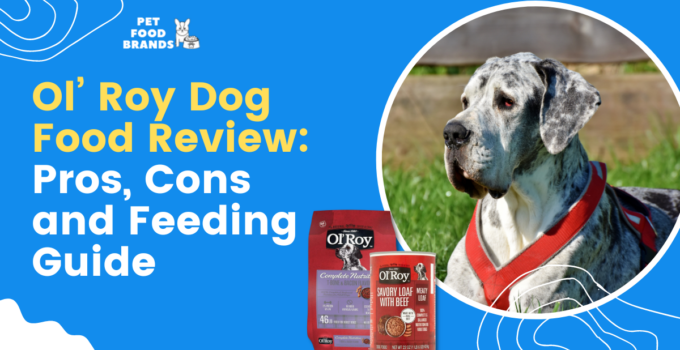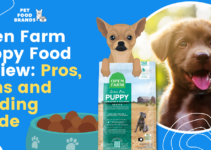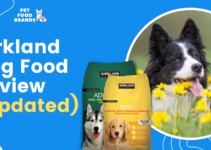All right, guys, today we have one of the top-selling dog foods of the last 15 years in the United States right here, and that food is called Ol’ Roy.
Ol’ Roy has swiftly dwindled in popularity because of the new revelations that have come out in the public eye about the quality of this dog food.
You’re at the right place if you need to learn your way around dog food. Let’s look at what Ol’ Roy offers and how you can decide if it serves you right.
Here are the three recipes I have chosen for this review:
| Products | Type | Special Feature | Our Rating | AAFCO Nutrient Profile(Life Stage) |
|---|---|---|---|---|
| Ol’ Roy Small Breed Adult Formula | Dry | Small bites | 1.5 | All Life Stages |
| Ol' Roy Complete Nutrition T-Bone & Bacon Flavor | Dry | Added Supplements | 2 | Adult Maintenance |
| Ol' Roy Savory Loaf with Beef | Wet | Meat Loaf | 3 | Adult Maintenance |
At a Glance Ol’ Roy Dog Food
Here are some key points to keep in mind about ol’ Roy dog food before we get into the review:
- Walmart Brand
- Highest Selling in the USA
- Highest number of recalls
- Allegedly linked to cancer in dogs
About The Brand Ol’ Roy Dog Food
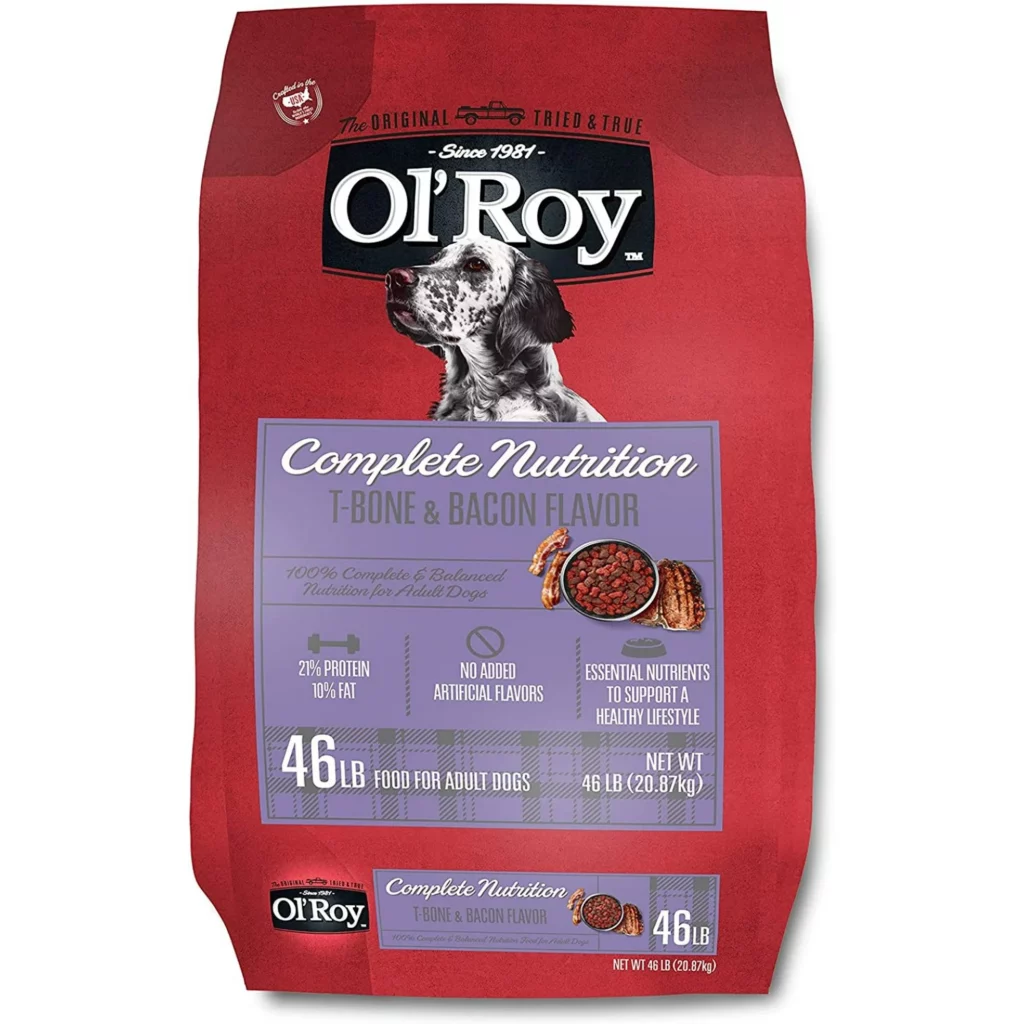
- Ol Roy Complete Nutrition
- At levels to provide your dog
- Treat your dog to the nutritious benefits and flavor of Ol Roy
*We earn a commission if you make a purchase, at no additional cost to you.
Ol’ Roy was first launched in 1983. When it first hit the shelves at Walmart, the dog food was named after Sam Walton, the founder of Walmart and Sam’s Club.
Doane Pet Care Company first made Ol’ Roy dog food, and the Mars Pet Food division owns Doane Pet Care.
Mars is one of the largest pet food manufacturers in the country. But before Mars purchased Doane Pet Food in 2006, Doane was an independent pet food manufacturer.
Walmart has never had a manufacturing plant for Ol’ Roy dog food. Still, the Mars Pet Food headquarters is in Brentwood, Tennessee.
Who Makes Ol’ Roy Dog Food in 2023?
Mars is the actual owner of Ol’ Roy. They’re the ones that make it for Walmart. It is the Walmart private brand, Ol’ Roy pet foods, made by Walmart Mars and Del Monte Snacks jerks and treats under the Ol’ Roy label, and Sunshine Company has made the Ol’ Roy biscuits.
Five-Factor Analysis of Ol’ Roy Dog Food
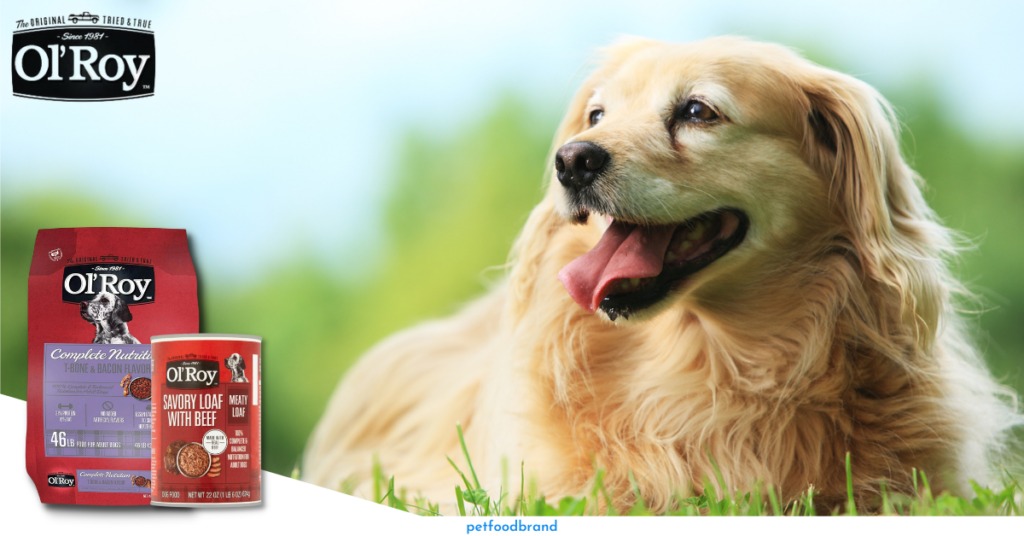
We need a standardized way of testing dog food. I choose the five most important factors- recipes, ingredients, nutrition, price, and recall history.
1. Recipes | ★★
Ol’ Roy Small Breed Adult Formula
- Ground Whole Corn is the first ingredient
- Bite-sized
- Omega 6
So this recipe contains ground corn meat and bone meal, soybean meal, wheat meal, and animal fat.
It’s preserved with BHA and BHT, ground wheat, natural flavoring, corn gluten, corn gluten meal, corn oil, flax seed, fish oil, minerals, and a whole bunch of stuff.
If I may add further, there is some artificial coloring that is added to this food!
I must admit it’s not the best food on the market because, nutrition-wise, we don’t like corn, wheat, soy products, or artificial coloring.
Ol’ Roy Complete Nutrition T-Bone & Bacon Flavor
- No added artificial flavors
- Whole-grain corn is the first ingredient
- Added vitamin supplements
The biggest scam companies can pull on customers is advertising food as nutritious when the ingredients are only supplements of the vitamins and minerals you’d find in good quality ingredients.
There is no T-bone in this recipe despite the name. It says natural T-bone “flavoring,” and even if there is a natural flavor, the ingredient is in such a small quantity that it makes no difference whatsoever.
This recipe contains all the unethical ingredients we’ll discuss in this article.
Ol’ Roy Savory Loaf with Beef Wet Dog Food
- The first ingredient is chicken
- Contains beef
- Healthy fats like Linoleic Acid
Wet food might be the only category of Ol’ roy that contains actual meat as the primary protein source.
However, these recipes are not without artificial coloring and harmful preservatives.
It also does not shy away from using soybean protein or meat by-products to make up the total protein value.
2. Ingredients | ★
Let’s dive into the ingredients and see what we’re looking at when it comes to the listings of the quality of this food. It gives us a better understanding of what we’re really giving our dogs.
Corn
Dogs have been fed cornmeal for decades, but it’s unhealthy.
Corn can cause your animal severe digestive issues, such as upset stomach, vomiting, diarrhea, nutritional deficiencies, weight loss, and even more severe issues, such as inflammatory bowel disease.
Cornmeal is not part of the canine diet; many dogs have had trouble digesting it. Cornmeal these days is especially nutritionally poor and mass-produced.
Any dog food that uses cornmeal or whole grain corn, especially if it’s the first ingredient which is the primary thing present in the food, is cheating you out of a good diet for your dog.
Chicken Meal
Meat and bone meal, or MBM, was once a staple animal product when cats and dogs were considered livestock.
It’s not to say that all chicken meals are bad. Still, the FDA allows companies to use 4D(dead, dying, diseased, or down), which makes it really easy for shady companies to do cost-cutting.
So that means they take the bodies of euthanized dogs and cats and grind them to make pet food. It means that during production, sodium pentobarbital, the drug used by veterinarians for euthanasia, might enter your dog’s pet food.
Chicken By-Product
The chicken by-product is a way to keep low-cost nutritional value for their food.
So, if you see this on a package, you’ll know they’re money-hungry, and you shouldn’t trust their food-Soybean meal. There’s really no case against this, but there’s no guarantee where it gets sourced from.
The chicken by-product is a good affordable ingredient for dog food. But these ingredients are not fresh.
Animal Fat
Animal fat used in dog food is scary. It’s basically mystery meat. Too much or too little animal fat can cause health issues.
And a big chunk of animal fat used in the pet food industry is saturated fats. High-quality animal fat is good for energy, insulation, and cushioning but has many other important roles.
But in foods like Ol’ Roy, this isn’t the case.
Corn Gluten
Despite its name, corn gluten has no gluten in it. The pet food industry uses corn gluten as an expensive protein source.
Corn gluten is a plant-based protein concentrate acting as a meat substitute that binds the kibble together. But the protein can come from almost anywhere, even from non-nutritious sources such as leather, hair, feathers, chicken beaks, etc.
Due to the high concentration, giving your dog food with corn gluten can cause the animal severe allergies to corn over an extended period.
Suppose your animal has an allergy to corn. In that case, it can also create issues such as hair loss, severe itching, scratching, scabs, and sores, and secondary infections, which are infections that occur after or during treatment for another infection or even staph or yeast pyoderma, which is a skin infection with the formation of pus.
Brewer’s Rice
The name already sounds like there’s something to it. But it’s a common carbohydrate in low-quality dog food.
Companies advertise this as a better alternative to regular rice, but it’s more or less the same. The chipped rice is left behind after the long rice grains are processed and packed.
Because this rice has broken down into smaller parts, most people prefer not to buy it, making it significantly cheaper to use in dog food.
BHA Preservative
It’s the most problematic ingredient in dog food, in my opinion. It helps preserve meat in your dog’s food so it doesn’t go rotten.
An example of this in human food is those little packets of beads you find in your beef jerky. But the difference is that this is inserted directly into your animal’s food. It’s what I believe causes dog cancer.
But this isn’t the case in low doses, especially if your dog eats the same dog food daily.
Citric Acid as a Preservative
In large quantities, citric acid can be toxic for dogs.
It can also cause bloating in your dog.
Artificial Coloring in Dog Food
Artificial coloring found in processed dog foods, like pet foods, has no place in a dog’s diet. It’s proven to cause behavioral problems and cancer in humans
3. Nutritional Analysis | ★★
Here’s a rough Nutritional Analysis based on the average nutritional values of Ol’ Roy dog food.
| Nutrient | Content (per serving) |
| Protein | 24% |
| Fat | 11% |
| Fiber | 5.1% |
| Moisture | NA |
| Carbohydrates | 57% |
The most interesting thing about this dog food is that it has a significantly higher amount of carbs than fat and protein, resulting from using lower-quality dog food ingredients.
Dogs do not need this many carbs in their diet because that is not their primary energy source.
The protein percentage here is almost negated because we’ve seen that this protein does not come from biologically appropriate sources for dogs.
4. Price | ★★★
It’s pocket-friendly, but you know what? There are foods that are way better and aren’t a lot more expensive than this. So, there is a huge difference between what you get and what you pay for.
You can get a 46 lb Bag of Ol’ Roy dry dog food for about 25-30 dollars which might seem like a sweet deal, and I get it- not everyone can afford expensive dog food, but there’s just no price you can put on your dog’s health.
There are multiple alternatives to this dog food in this price range that are very transparent about their ingredients.
5. Recall History | ★
Now, don’t get me wrong, there are a lot of foods that get recalled for other things. It just so happens that Ol’ Roy has had the most recalls since 2005 of any dog food in the United States. So, that’s concerning.
In November 1998, there were reports of sickness and death of around 25 dogs.
If you don’t know what the melamine crisis is, the FDA learned on March 15, 2007 that “certain pet foods were sickening and killing cats and dogs.” The FDA found toxic contaminants in vegetable proteins found in animal food.
In early 2018, their turkey strips bacon was recalled due to possibly low levels of pentobarbital. If you don’t know what pentobarbital is, you’d be shocked to know that it’s an anesthetic drug that can only find its way to your dog food if it contains euthanized animals, or at least that’s the suspicion.
In March 2007, all kinds of recipes and bags of Ol’ Roy dog food were recalled due to melamine, shocking the entire country. Melamine is a synthetic compound used in plastic.
In June 2006, many canned dog food recipes got recalled because, inside the cans, the separation lining was “flaking.”
Besides this, there have been countless Salmonella-related recalls.
How Does Ol’ Roy Dog Food Compare to the Competition?

Ol’ Roy is often compared to Purina because they sell a lot in the US. Although both have their grasp on the market, there are some major differences to consider.
Purina strictly uses a meat-first policy for all of its dog food. Their formulas are more nutritionally balanced than any Ol’ Roy recipe.
I have my reservations about Purina as well. Still, it definitely does a better job than Ol’ Roy, even if it’s marginal.
Should You Buy Ol’ Roy Dog Food?
Thousands of other pet parents have reviewed this and seen their pet’s health worsening. I would advise you not to buy it but to look for better dog food in an affordable range. Sure, it might be easier just to get one of these from a Walmart shelf, but searching for good dog food you feed your pet daily pays off in the long run.
Pros
- Affordable
- Easily available
Cons
- Most recalled brand in the USA
- Low-quality ingredients
- Ingredients linked with cancer
Our Rating

FAQ’s
Who is Ol’ Roy’s dog food made by?
Mars manufactures Ol’ Roy dog food, but it is a private label by Walmart. It was named after Walmart Founder Sam Walton’s dog.
When did Ol’ Roy’s dog food come out?
Ol’ Roy dog food came out in 1981 by Doane Pet Care Company and was then handed over to Mars.
Is Ol’ Roy dog food safe?
It is safe enough to be allowed in the United States market for dog food. But many customers have reported that the long-term effects of this dog food are harmful, with the biggest threat being cancer.
Before You Go
It’s scary to know that it’s a very popular brand. Yeah, not very pleased with the Ol’ Roy. And if you say, ‘My dog doesn’t eat Ol’ Roy,’ he probably eats from the same company. After all, Mars owns 50-plus pet food brands. So unless your dog eats some indie amazing non-mainstream underground Etsy-shop-type stuff, I bet your dog has eaten something similar to Ol’ Roy.

Ankita is a passionate pet lover and head of content at Pet Food Brands. With her extensive knowledge and research, she provides pet owners with top-quality information on dog food and nutrition. Her dedication to improving the lives of dogs makes her a leading voice in the industry.

